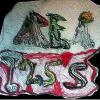The following post is only about halfway complete. It will be added to later, and updated from time to time.
*************************************************
This thread is meant to give an introduction to what is known of the neurochenistry of autism, with particular focus on the unusual balance found between GABA and glutamate. Other aspects may be covered in future threads.
Autism is not one thing, it is a collection of conditions which have some similarities, but over a thousand genes have been implicated as possibly involved, so what is true of one autistic person may be quite inapplicable to another. The broader autism phenotype includes autism as identified by Kanner and Asperger, as well as ADHD, OCD and tic disorders, which frequently overlap with autism. All of these show ties to GABA/glutamate dysregulation, often involving SLC1A1/EAAC1 glutamate transport, leading to excess glutamate18,20. Epilepsy is also common among autistic people, affecting somewhere between 15 and 35 percent. High levels of glutamate are also implicated in most forms of epilepsy. Now for the technical breakdown.
Hyperglutamatergy is exhibited in the serum levels of more intelligent autistic children1, autistic children in general2, and autistic adults3,15. Excess glutamate is also found in the hippocampus and frontal lobes, striatum, anterior cingulate cortex/gyrus4, auditory cortex, and the cerebellum, which has led to successful use of antiglutamatergic drugs in treatment5,6. The glutamate/GABA imbalance is a possible cause of CNS inflammation and oxidative damage in autistics15.
Conversion of glutamate into GABA is often quite minimal, despite large numbers of GABA neurons in parts of the brain, as the receptors seem to be downregulated. This appears to be linked to problems with GAD65 and GAD67, the two isoforms of glutamic acid decarboxylase, which convert glutamate into GABA17. In the parietal and cerebellar cortexes of autistic people, GABA exists at only about half the levels found in neurotypicals5. Low GABA has also been addressed in several successful treatments, including memantine, valproate, carbamazepine and arbaclofen7,8,9,13,16. These naturally counterbalance glutimate in the process. Glycine inhibition has also been used successfully to control runaway glutamate in a knockout mouse model, although it caused behavioral anomalies in the control group, so was not tried with humans.10 In Rett Syndrome, which is (along with Fragile X) often considered close enough to autism to be a useful model, excessive glutamate is tied to SNAT1 glutamate transporter overexpression, with similar outcome11.
While antagonizing glutamate and agonizing GABA are effective approaches5,12, they are also blunt instruments. Some initial attempts have been made to find and analyze the mGluRs involved, but the material's still pretty sketchy, and there's a lot left to be done. mGluR group I (1,5) is looking like a trouble area17, and mGluR5 suppression with MPEP has worked in a knockout mouse model13, and can improve their memory as well as remedying other deficits14.
*********** To be continued ****************
--------------------------------------
1. Alteration of Plasma Glutamate and Glutamine Levels in Children with High-Functioning Autism. http://journals.plos...al.pone.0025340
2. Nutritional and metabolic status of children with autism vs. neurotypical children, and the association with autism severity. http://www.biomedcen...3-7075-8-34.pdf
3. Increased serum levels of glutamate in adult patients with autism. http://www.sciencedi...278584606002697
4. Relationship among Glutamine, γ-Aminobutyric Acid, and Social Cognition in Autism Spectrum Disorders. http://www.ncbi.nlm....pubmed/25919578
5. The role of glutamate and its receptors in autism and the use of glutamate receptor antagonists in treatment. http://www.ncbi.nlm....les/PMC4134390/
6. A Review on GABA/Glutamate Pathway for Therapeutic Intervention of ASD and ADHD. http://www.ncbi.nlm....pubmed/25666800
7. Mood Stabilizers in Children and Adolescents With Autism Spectrum Disorders. http://www.ncbi.nlm....pubmed/26366961
8.R-Baclofen Reverses a Social Behavior Deficit and Elevated Protein Synthesis in a Mouse Model of Fragile X Syndrome. http://www.ncbi.nlm....pubmed/25820841
9. Astroglial glutamate transporter deficiency increases synaptic excitability and leads to pathological repetitive behaviors in mice. http://www.ncbi.nlm....pubmed/25662838
10.Effects of VU0410120, a novel GlyT1 inhibitor, on measures of sociability, cognition and stereotypic behaviors in a mouse model of autism. http://www.ncbi.nlm....pubmed/25784602
11. Dysregulation of glutamine transporter SNAT1 in Rett syndrome microglia: a mechanism for mitochondrial dysfunction and neurotoxicity. http://www.jneurosci.../35/6/2516.long
12. A Review on GABA/Glutamate Pathway for Therapeutic Intervention of ASD and ADHD. http://www.ncbi.nlm....pubmed/25666800
13. Social deficits in IRSp53 mutant mice improved by NMDAR and mGluR5 suppression. http://www.ncbi.nlm....pubmed/25622145
14. Enhancement of Short-Term Memory by Methyl-6-(Phenylethynyl)-Pyridine in the BTBR T+tf/J Mouse Model of Autism Spectrum Disorder. http://www.ncbi.nlm....les/PMC4384677/
15. GABAergic/glutamatergic imbalance relative to excessive neuroinflammation in autism spectrum disorders. http://www.ncbi.nlm....les/PMC4243332/
16. A Review of Traditional and Novel Treatments for Seizures in Autism Spectrum Disorder: Findings from a Systematic Review and Expert Panel. http://www.ncbi.nlm....les/PMC3859980/
17. Consensus Paper: Pathological Role of the Cerebellum in Autism. http://www.ncbi.nlm....les/PMC3677555/
18. Family-Based Association Testing of OCD-Associated SNPs of SLC1A1 in an Autism Sample. http://www.ncbi.nlm....les/PMC2688703/
19. Isoforms of the neuronal glutamate transporter gene, SLC1A1/EAAC1, negatively modulate glutamate uptake: relevance to obsessive-compulsive disorder. http://www.ncbi.nlm....les/PMC3669922/
20. Brief Report: Glutamate Transporter Gene (SLC1A1) Single Nucleotide Polymorphism (rs301430) and Repetitive Behaviors and Anxiety in Children with Autism Spectrum Disorder. http://www.ncbi.nlm....les/PMC4348063/
Edited by nootist, 24 September 2015 - 06:06 AM.




















































